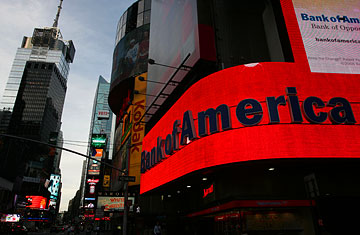
A Bank of America branch in New York City
Timothy Geithner, you're on your own. If Geithner, who was confirmed as Treasury Secretary late Monday, plans on waiting until a consensus forms on what to do with the second half of the $700 billion bank rescue fund approved by Congress in early October, he may be waiting awhile. Economists, Wall Streeters and industry analysts are split on how best to spend what remains in the Troubled Asset Relief Program (TARP), which has done anything but offer relief.
Bank stocks have continued to plummet since the program was started in mid-October. Two of the nation's largest banks, Citigroup and Bank of America, have had to tap the relief fund twice, yet neither bank appears any more stable. Indeed, concerns about Bank of America's insolvency have grown, not shrunk, in the past few months. What's more, none of the government money spent so far has done anything to increase lending or lower foreclosures. (See the best business deals of 2008.)
"It's clear we need to do a lot more," says David Duffie, a finance professor at Stanford Graduate School of Business. "The losses at these banks are getting bigger and bigger."
But what to do? The only thing observers agree on is that none of the options are savory. Some economists believe we should stick with the current plan, and continue to buy up preferred shares in bank stocks. But a growing number of economists and industry watchers say we need a new direction. Among the ideas being floated are having the government take over the banks that are in the worst shape, creating a "bad" bank that would buy up the mortgage bonds and other assets, or changing accounting rules to protect banks from future loan losses.
What's clear is that Geithner, unlike his predecessor Henry Paulson, does not face a growing chorus of voices calling for a particular plan. Initially, Paulson was reportedly in favor of spending TARP money to buy up troubled assets. But shortly after the bank rescue fund passed Congress, a flood of economists came out against Paulson's plan. Instead, most policy experts advocated a plan to inject capital into the banks by buying preferred shares. The latter strategy would be quicker to implement and would do a better job of stimulating lending. Britain was instituting a similar plan, and it was already gaining praise. So Paulson balked, and by late October the capital-purchase plan was in place. The original TARP was dead in the water. (See the top 10 financial-crisis buzzwords.)
These days, however, few people think the capital-purchase plan makes sense. Paul Miller, an analyst at Friedman Billings Ramsey who covers bank stocks, says the problem with it is that the government is buying preferred shares and not common stock. Miller says preferred equity does nothing to help out common shareholders. That's because holders of preferred shares can demand their money back before holders of common stock can. As a result, bank stocks continue to plummet. And no matter how much total capital a bank or any firm has, if its stock goes to zero, it can't really operate.
That's why Miller argues that the government should start buying up common stock in the troubled banks, which would boost their stock prices, erase the perception of imminent failure and remove the likelihood that customers will run with their money. It may even boost lending. Of course, the problem with this is that some of these banks might need too much capital — and if the government buys all the common stock needed to fix the problem, it will own the banks, possibly a few times over. So a switch to buying common stock points to nationalization. (See pictures of the top 10 scared traders.)
Few economists like the idea of the government buying up banks and running them. Congress seems to have little taste for it as well. That's why the government came up with the preferred-share plan in the first place. The fear is that the government would do a worse job of running the banks than the current executives. What's more, once the government owns a bank, it has to pay for everything, from keeping the lights on to severance. And that could get very costly.
